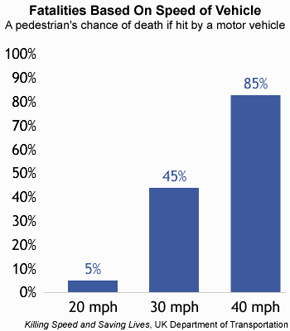Meet Hank, the Guy CDOT Created to Scold People Who Get Hit By Drivers
Ever wonder what runs through the bureaucratic hive mind of a transportation agency still laboring under last century’s paradigm, trying to evade culpability for designing wide, fast, deadly roads? An agency that thinks the key to remaining relevant is to tweak the same old messages for a Millennial audience by posting to the social medias and the YouTubes?
Wonder no more: The Colorado Department of Transportation launched a tasteless “pedestrian safety” campaign yesterday that answers all your questions.
CDOT, understanding the power of satire, attempts to make getting hit by a driver humorous. You see, according to a press release, there’s this “approachably sarcastic and unassumingly charming salesman” named Hank. Hank wants to sell you VHS tapes on how to get hit by cars. Hank, you rascal. No one wants to get hit by a car. Ha!
Hank informs viewers that the best ways to invite death and serious injury while walking are to use a phone while crossing the street and to cross without a crosswalk. (Follow Hank on Facebook to get updates on the different breeds of mockable pedestrians, such as Texter Tuck & Roll, the Scotch & Soda Stumble, and the I Could Care Less Crosser.)
I wonder if Hank has ever tried navigating Colfax Avenue, Federal Boulevard, Sheridan Boulevard, or Colorado Boulevard — all state highways under CDOT’s jurisdiction — on foot. Take the section of Colfax Avenue from Colorado Boulevard to Cherry Street, for example: There’s a span of seven intersections with zero crosswalks.

I asked CDOT traffic safety communications manager Sam Cole why the agency would choose this message when crosswalks are so few and far between. Does CDOT expect people to see their destination across the street and walk 20 minutes out of their way to get to it?
“To me that’s a safer approach than just throwing in the towel,” Cole said. “You are risking your life if you continuously [cross without a crosswalk]. We know that most of the places these deaths are happening at are where people don’t use crosswalks.”
Probably because they don’t exist.
If Hank were a real person, instead of CDOT incarnate, would he change his tune if he knew that most of the people killed while walking or biking in Denver had their lives snuffed out on one of the agency’s urban highways? These CDOT roads criss-cross the metro area and the state, and they all have one thing in common: They were built to move cars fast, not allow people to safely navigate them on foot.
So, maybe CDOT could invest in safer street designs on its urban highways? Nah. Hank isn’t about that. Hank is all about shifting attention away from deadly engineering practices by blaming victims instead. That’s what “education” amounts to in this context.
Surely, there’s at least a similar education campaign aimed at drivers looking out for pedestrians, seeing as how people walking or using a wheelchair are any street’s most vulnerable user, no matter who’s at fault.
“We don’t have a direct campaign that says, ‘Drivers, be careful of pedestrians,’ because I think all drivers know they need to be careful about pedestrians,” Cole said.
Okay then, no need for Hank to educate drivers. People on foot have to be told that they can be killed by multi-ton vehicles moving at 40 or 50 mph, but drivers just instinctively know how to avoid harming other people. Drivers are already aware that if they hit a pedestrian at 40 mph, there’s an 85 percent likelihood that person will die.
Hank is straight out of the 1950s, and so is the mentality he represents. Putting the onus on pedestrians to survive absolves drivers from using streets responsibly and DOTs from designing them for everyone.


